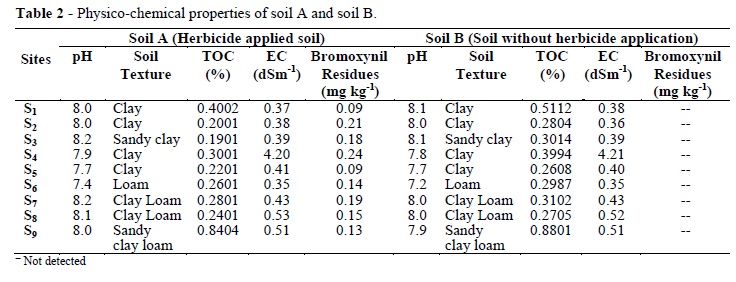The present study aimed to evaluate the effect of bromoxynil herbicide on soil microorganisms, with the hypothesis that this herbicide caused suppression in microbial activity and biomass by exerting toxic effect on them. Nine sites of Punjab province (Pakistan) those had been exposed to bromoxynil herbicide for about last ten years designated as soil 'A' were surveyed in 2011 and samples were collected and analyzed for Microbial Biomass Carbon (MBC), Biomass Nitrogen (MBN), Biomass Phosphorus (MBP) and bacterial population. Simultaneously, soil samples from the same areas those were not exposed to herbicide designated as soil 'B' were taken. At all the sites MBC, MBN and MBP ranged from 131 to 457, 1.22 to 13.1 and 0.59 to 3.70 µg g-1 in the contaminated soils (Soil A), which was 187 to 573, 1.70 to 14.4 and 0.72 to 4.12 µg g-1 in the soils without contamination (soil B). Bacterial population ranged from 0.67 to 1.84x10(8) and 0.87 to 2.37x10(8) cfu g-1 soil in the soils A and B, respectively. Bromoxynil residues ranged from 0.09 to 0.24 mg kg-1 at all the sites in soil A. But no residues were detected in the soil B. Due to lethal effect of bromoxynil residues on the above parameters, considerable decline in these parameters was observed in the contaminated soils. Results depicted that the herbicide had left toxic effects on soil microbial parameters, thus confirmed that continuous use of this herbicide affected the quality of soil and sustainable crop production.
biomass; buctril super; bacteria; effect; population




